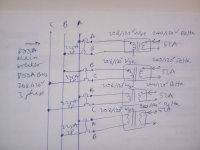fandi
Senior Member
- Location
- Los Angeles
- Occupation
- Electrical Engineer
Hello All,
An engineer connects (4) 240V Energy Storage System (ESS) to an 800A 208/120V switchboard via (4) 37.5kVA Delta(240V)/Wye(208V) transformers using 120% rule method. Per his calculations, 52A (ESS output) on the 240V side of the transformers which is (52*240)/208=60A on the 208V side of the transformers.
T1 connects to phase A and B.
T2 connects to phase A and C.
T3 connects to phase B and C.
T4 connects to phase A and B.
He then uses vector addition (parallelogram rule) to calculate the line currents:
I1=I2=158.75A, I3=103.92A
Per 2020 NEC 705.12(B)(3)(2), max backfeed is 800A busx120%-800A main breaker=160A.
My question about the wordings of the code section 705.12(B)(3)(2) is:
Is 160A max backfeed per phase (A, B or C)? Because if it is then I think he's fine: on 208V side at the 800A switchboard, max phase current is 158.75A < 160A.
Please see the diagram sketch for the connection configuration.
Thank you.

An engineer connects (4) 240V Energy Storage System (ESS) to an 800A 208/120V switchboard via (4) 37.5kVA Delta(240V)/Wye(208V) transformers using 120% rule method. Per his calculations, 52A (ESS output) on the 240V side of the transformers which is (52*240)/208=60A on the 208V side of the transformers.
T1 connects to phase A and B.
T2 connects to phase A and C.
T3 connects to phase B and C.
T4 connects to phase A and B.
He then uses vector addition (parallelogram rule) to calculate the line currents:
I1=I2=158.75A, I3=103.92A
Per 2020 NEC 705.12(B)(3)(2), max backfeed is 800A busx120%-800A main breaker=160A.
My question about the wordings of the code section 705.12(B)(3)(2) is:
Is 160A max backfeed per phase (A, B or C)? Because if it is then I think he's fine: on 208V side at the 800A switchboard, max phase current is 158.75A < 160A.
Please see the diagram sketch for the connection configuration.
Thank you.

